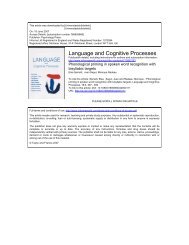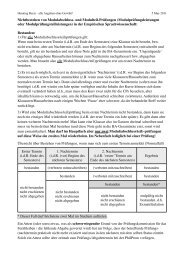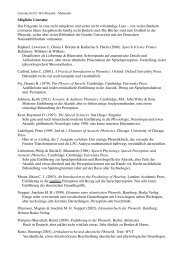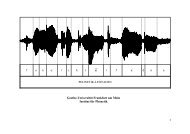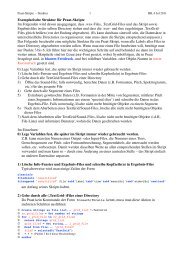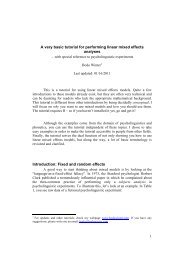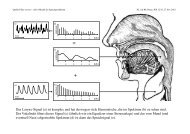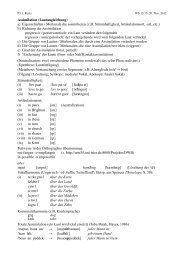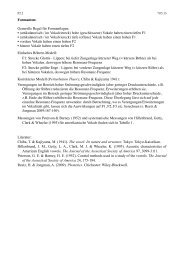Variation and assimilation in German - Institut für Phonetik
Variation and assimilation in German - Institut für Phonetik
Variation and assimilation in German - Institut für Phonetik
Create successful ePaper yourself
Turn your PDF publications into a flip-book with our unique Google optimized e-Paper software.
558 COENEN, ZWITSERLOOD, AND BOÈLTE<br />
The gestural model, which elegantly deals with partial <strong>assimilation</strong>,<br />
could expla<strong>in</strong> our data from Experiment 1 if residual traces of the orig<strong>in</strong>al<br />
gesture were present <strong>in</strong> the signal. In fact, Nolan (1992) showed that such<br />
traces can be utilised by listeners even when these traces are not detectable<br />
with electropalatography. Although we tried hard to produce a complete<br />
segment change, we have no way of know<strong>in</strong>g whether such traces were<br />
present <strong>in</strong> our segments. Given the close correspondence between<br />
articulation <strong>and</strong> perception <strong>in</strong> this model, it could expla<strong>in</strong> our nd<strong>in</strong>gs<br />
even <strong>in</strong> the absence of acoustic traces.<br />
How does underspecication fare <strong>in</strong> the light of our results? The theory<br />
correctly predicts no effects when changes are phonologically illegal. But<br />
other aspects are problematic for underspecication. Firstly, underspecied<br />
representations should not bother with context to license a<br />
change <strong>in</strong> surface form. But we clearly nd that a licens<strong>in</strong>g context is a<br />
prerequisite. Second, how would underspecication h<strong>and</strong>le our results for<br />
<strong>assimilation</strong> of voice? One could argue for [voiced] as the unspecied<br />
feature, allow<strong>in</strong>g voiced segments to be devoiced. But it rema<strong>in</strong>s unclear<br />
how underspecication could h<strong>and</strong>le the quantitative differences between<br />
regressive place <strong>and</strong> progressive voice <strong>assimilation</strong>. Also somewhat<br />
problematic for this theory are the null effects for legal progressive place<br />
<strong>assimilation</strong> <strong>in</strong> viable context. It is not easy to th<strong>in</strong>k of rules which would<br />
block place <strong>assimilation</strong> at word onset, while allow<strong>in</strong>g it elsewhere. As<br />
argued earlier, such rules cannot generally apply to word onsets, because<br />
we nd effects for voice at this position.<br />
So, underspecication alone cannot expla<strong>in</strong> the results. Additional<br />
mechanisms have to be operative. There are two proposals <strong>in</strong> the<br />
literature: <strong>in</strong>ference <strong>and</strong> anticipation. Gaskell <strong>and</strong> Marslen-Wilson<br />
(1996) assumed a process of phonological <strong>in</strong>ference that evaluates the<br />
contextual appropriateness of <strong>assimilation</strong>s. Lahiri (1995) argues aga<strong>in</strong>st<br />
such an <strong>in</strong>ference process. Based on data from an experiment on <strong>German</strong>,<br />
she proposed a comb<strong>in</strong>ation of underspecifed lexical representations with<br />
an anticipation mechanism. In her unviable contexts, assimilated words led<br />
to longer latencies than unchanged words. This she <strong>in</strong>terprets as an<br />
anticipation effect. The presence of a change creates the expectancy that a<br />
segment with particular features (e.g., labial or velar) should come next.<br />
This anticipation is not satised <strong>in</strong> unviable contexts. Such an anticipation<br />
explanation was also provided by Otake et al. (1996), for Japanese, by<br />
Lahiri <strong>and</strong> Marslen-Wilson (1991), for nasalised vowels <strong>in</strong> English, <strong>and</strong> by<br />
Gow (2000), for cases of <strong>assimilation</strong> <strong>in</strong> which the orig<strong>in</strong>al place feature is<br />
not completely neutralised. Our data are hard to reconcile with Lahiris<br />
underspecication-cum-anticipation view. First, it predicts no difference<br />
between unchanged <strong>and</strong> legally changed words <strong>in</strong> viable contexts. But we<br />
do nd such differences. Moreover, the view predicts slower responses <strong>in</strong>



